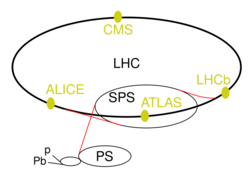Physics:MoEDAL experiment
 | |
| LHC experiments | |
|---|---|
| ATLAS | A Toroidal LHC Apparatus |
| CMS | Compact Muon Solenoid |
| LHCb | LHC-beauty |
| ALICE | A Large Ion Collider Experiment |
| TOTEM | Total Cross Section, Elastic Scattering and Diffraction Dissociation |
| LHCf | LHC-forward |
| MoEDAL | Monopole and Exotics Detector At the LHC |
| FASER | ForwArd Search ExpeRiment |
| LHC preaccelerators | |
| p and Pb | Linear accelerators for protons (Linac 2) and Lead (Linac 3) |
| (not marked) | Proton Synchrotron Booster |
| PS | Proton Synchrotron |
| SPS | Super Proton Synchrotron |
MoEDAL (Monopole and Exotics Detector at the LHC) is a particle physics experiment at the Large Hadron Collider (LHC).
Experiment
MoEDAL shares the cavern at Point 8 with LHCb, and its prime goal is to directly search for the magnetic monopole (MM)[1][2][3][4][5][6][7][8] or dyon and other highly ionizing stable massive particles (SMPs) and pseudo-stable massive particles via the Schwinger effect.[9] To detect these particles, the project uses nuclear track detectors (NTDs), which suffer characteristic damage due to highly ionizing particles. As MMs and SMPs are highly ionizing, NTDs are perfectly suited for the purpose of detection.
It is an international research collaboration whose spokesperson is the University of Alberta's James Pinfold. It is the seventh experiment at the LHC, was approved and sanctioned by the CERN research board in May 2010, and started its first test deployment in January 2011.[10]
In 2012 MoEDAL accuracy surpassed accuracy of similar experiments. A new detector was installed in 2015,[11] but as of 2017 it also did not find any magnetic monopoles, setting new limits on their production cross section.[12]
References
- ↑ Giacomelli, G.; Sioli, M. (2002). "Astroparticle Physics". arXiv:hep-ex/0211035.
- ↑ Giacomelli, G.; Patrizii, L. (2001). "Magnetic Monopoles". arXiv:hep-ex/0112009.
- ↑ Kalbfleisch, G. R.; Milton, K. A.; Strauss, M. G.; Gamberg, L.; Smith, E. H.; Luo, W. (2000). "Improved Experimental Limits on the Production of Magnetic Monopoles". Physical Review Letters 85 (25): 5292–5295. doi:10.1103/PhysRevLett.85.5292. PMID 11135979. Bibcode: 2000PhRvL..85.5292K.
- ↑ Milton, K. A.; Kalbfleisch, G. R.; Strauss, M. G.; Gamberg, L.; Luo, W.; Smith, E. H. (2000). "New Limits on the Production of Magnetic Monopoles at Fermilab". arXiv:hep-ex/0009003.
- ↑ Abbott, B. (1998). "Search for Heavy Pointlike Dirac Monopoles". Physical Review Letters 81 (3): 524–529. doi:10.1103/PhysRevLett.81.524. Bibcode: 1998PhRvL..81..524A.
- ↑ Giacomelli, G. (1984). "Magnetic monopoles". Rivista del Nuovo Cimento 7 (12): 1–111. doi:10.1007/BF02724347. Bibcode: 1984NCimR...7l...1G.
- ↑ Acciarri, M. (1995). "Search for anomalous Z → γγγ events at LEP". Physics Letters B 345 (4): 609–616. doi:10.1016/0370-2693(95)01612-T. Bibcode: 1995PhLB..345..609A. https://cds.cern.ch/record/273745.
- ↑ Gamberg, L.; Kalbfleisch, G. R.; Milton, K. A. (2000). "Direct and Indirect Searches for Low-Mass Magnetic Monopoles". Foundations of Physics 30 (4): 543–565. doi:10.1023/a:1003668812097. Bibcode: 2000FoPh...30..543G.
- ↑ "MoEDAL bags a first" (in en). https://home.cern/news/news/physics/moedal-bags-first.
- ↑ Pinfold, J. (5 May 2010). "MoEDAL becomes the LHC's magnificent seventh". CERN Courrier. http://cerncourier.com/cws/article/cern/42329.
- ↑ Acharya, B. (2016). "Search for magnetic monopoles with the MoEDAL prototype trapping detector in 8 TeV proton-proton collisions at the LHC". Journal of High Energy Physics 2016 (8): 67. doi:10.1007/JHEP08(2016)067. Bibcode: 2016JHEP...08..067A.
- ↑ Acharya, B. (2017). "Search for Magnetic Monopoles with the MoEDAL Forward Trapping Detector in 13 TeV Proton-Proton Collisions at the LHC". Physical Review Letters 118 (6): 061801. doi:10.1103/PhysRevLett.118.061801. PMID 28234515. Bibcode: 2017PhRvL.118f1801A.
External links
[ ⚑ ] 46°14′09″N 6°03′18″E / 46.235753°N 6.055092°E
 |


